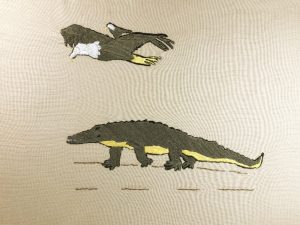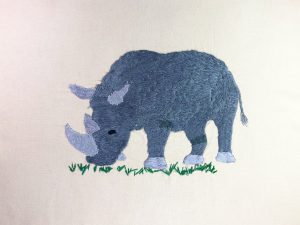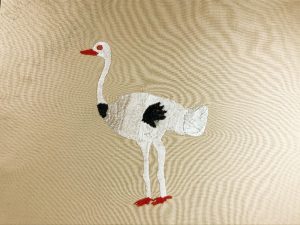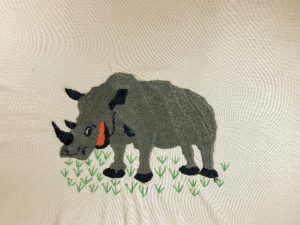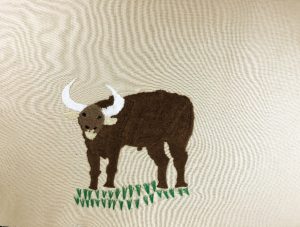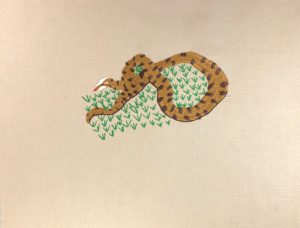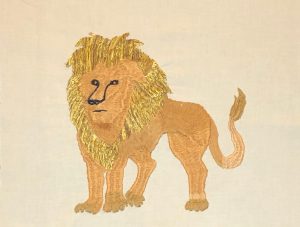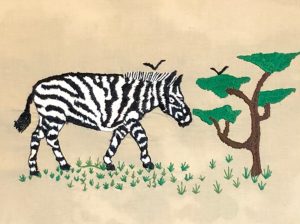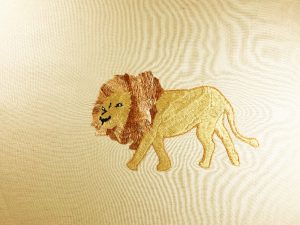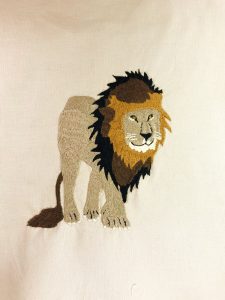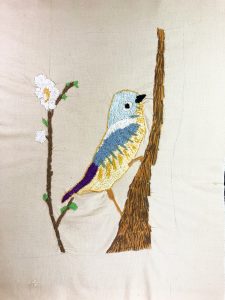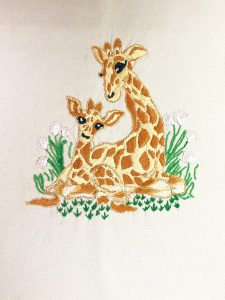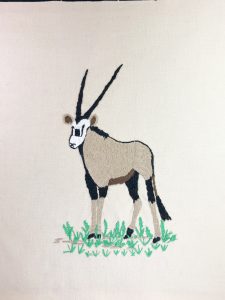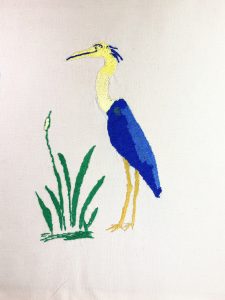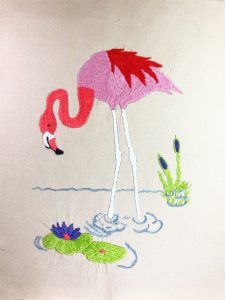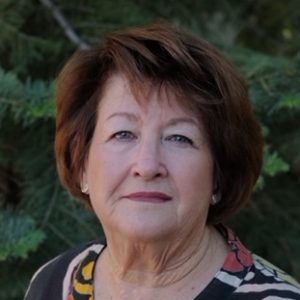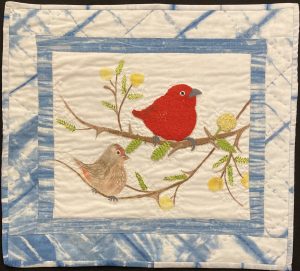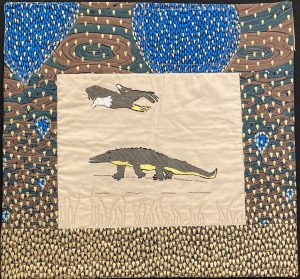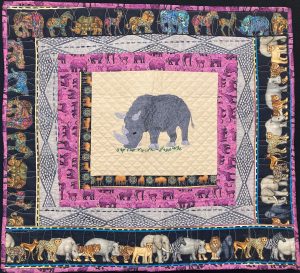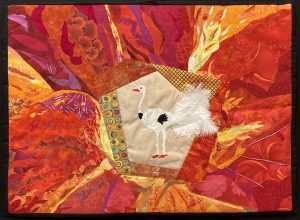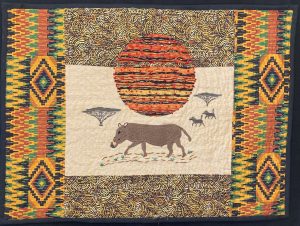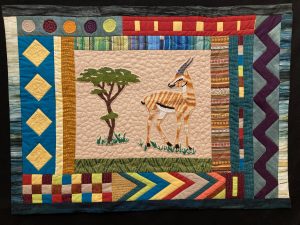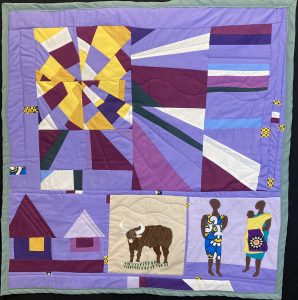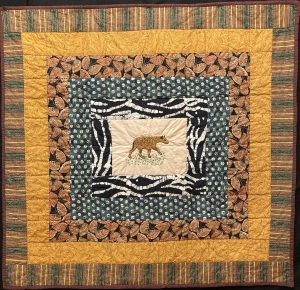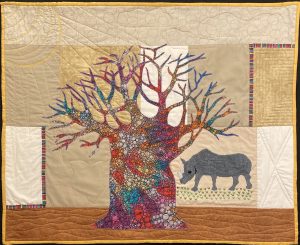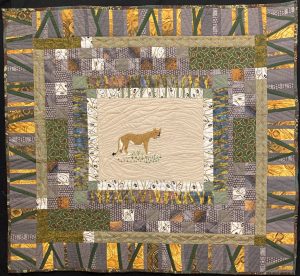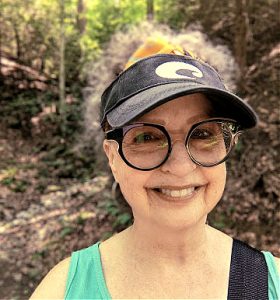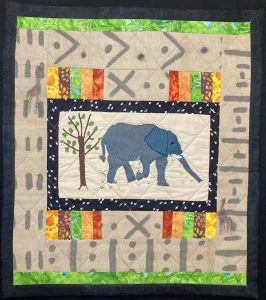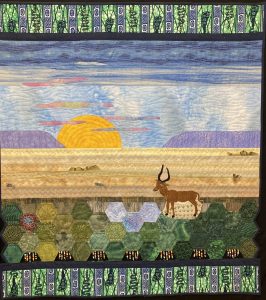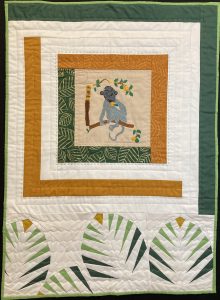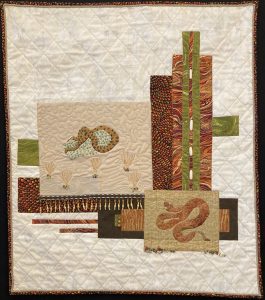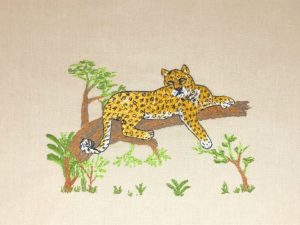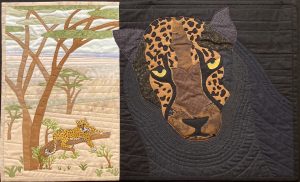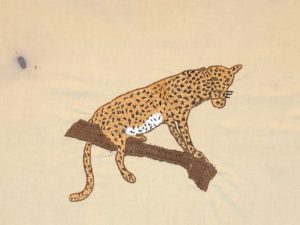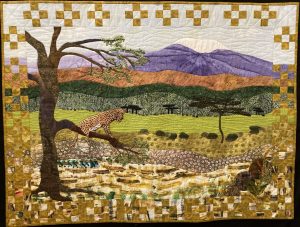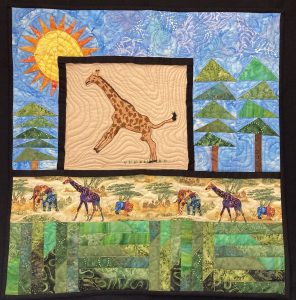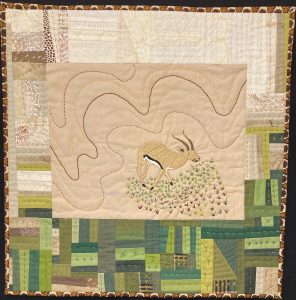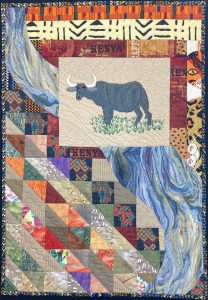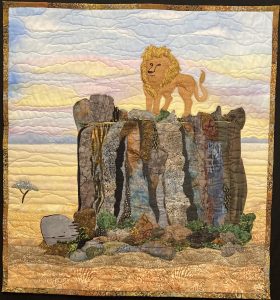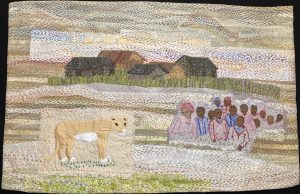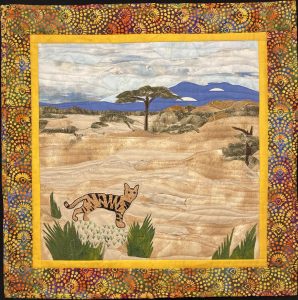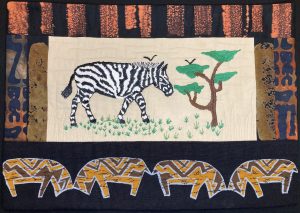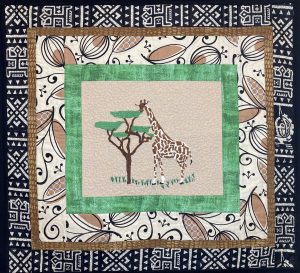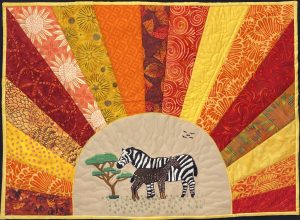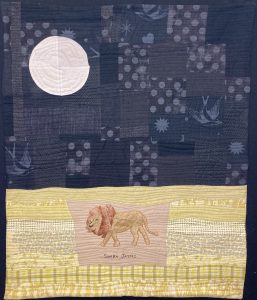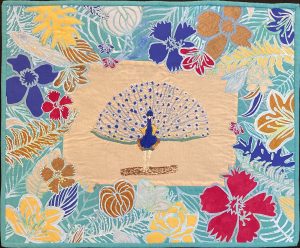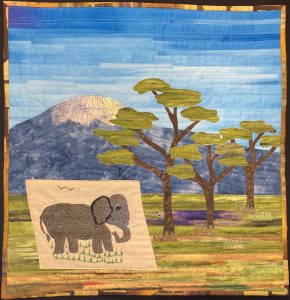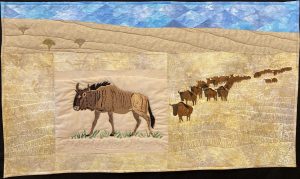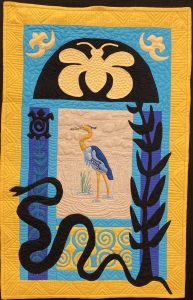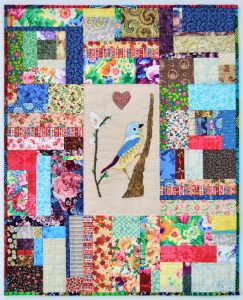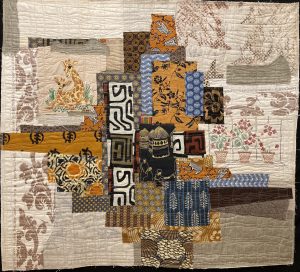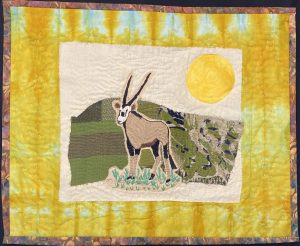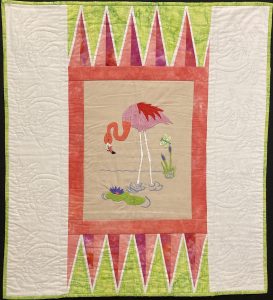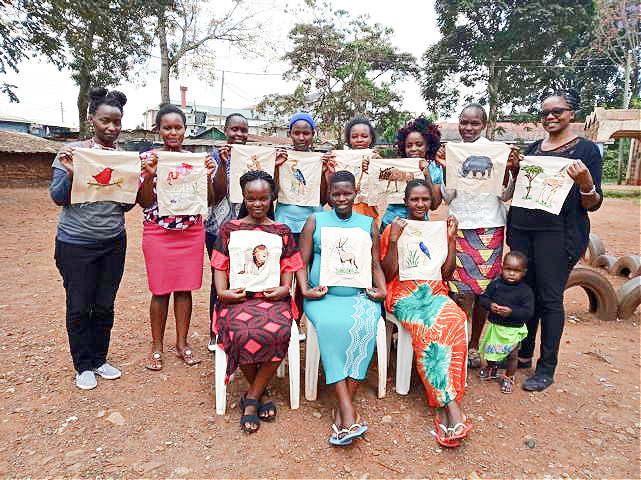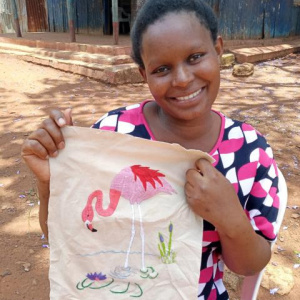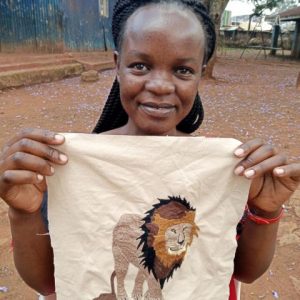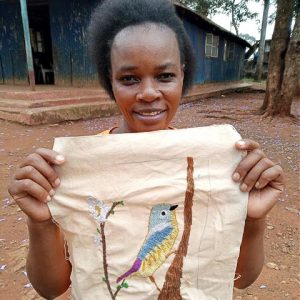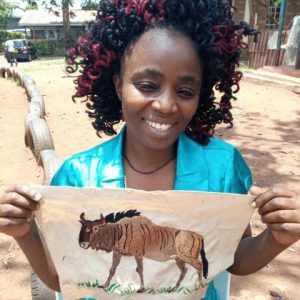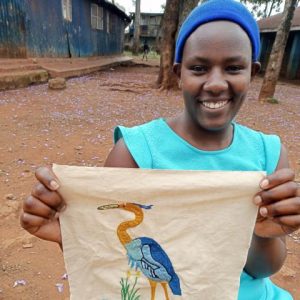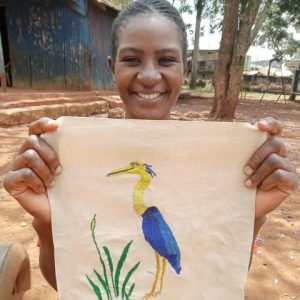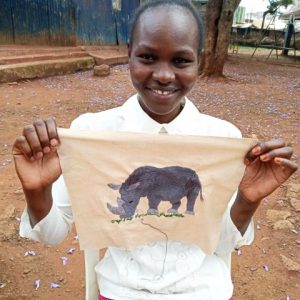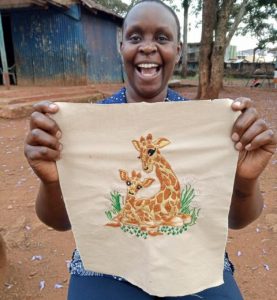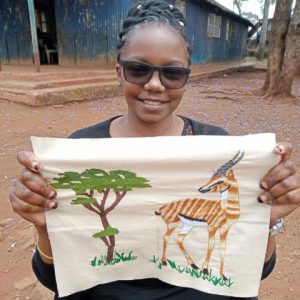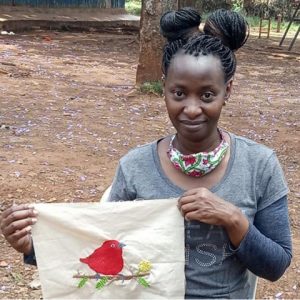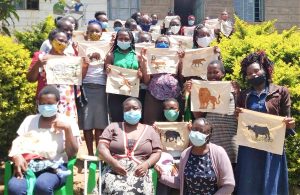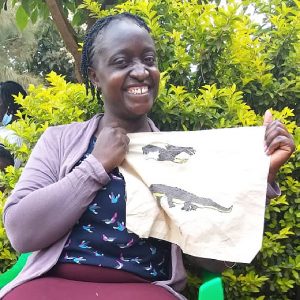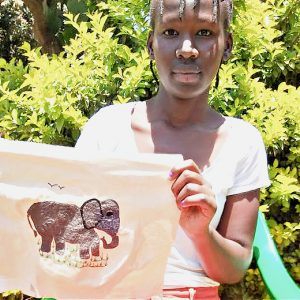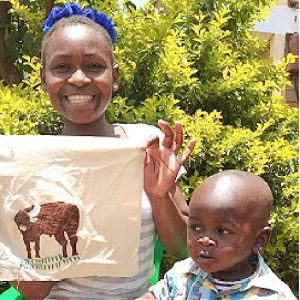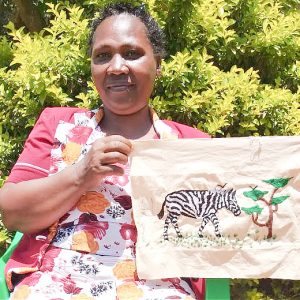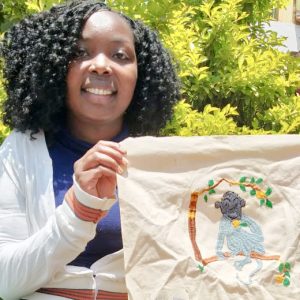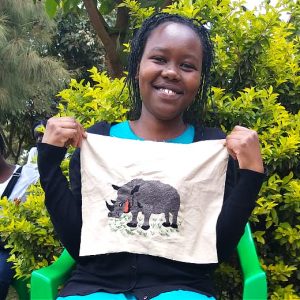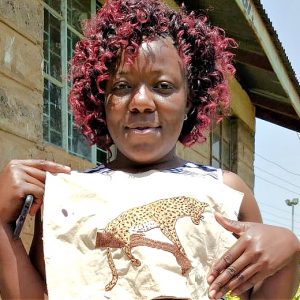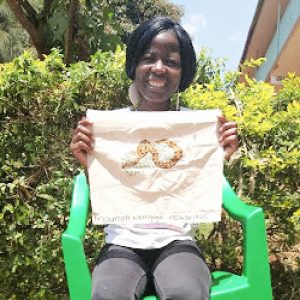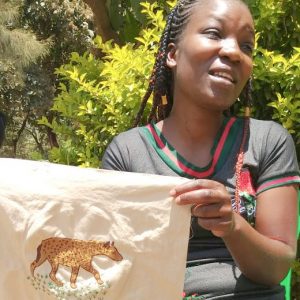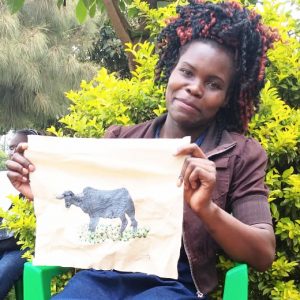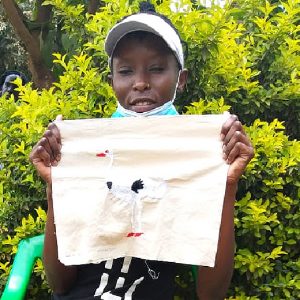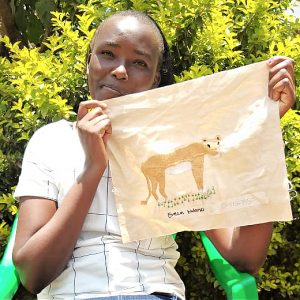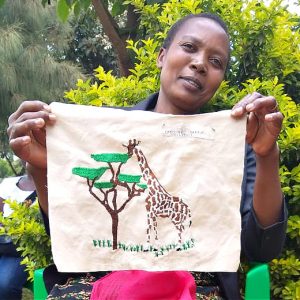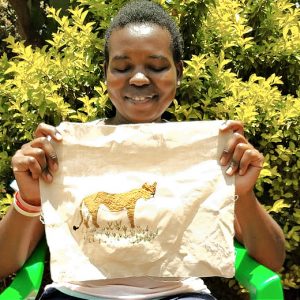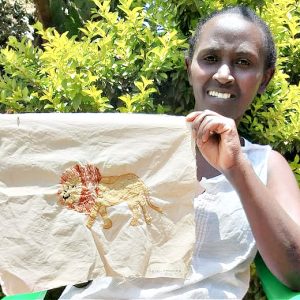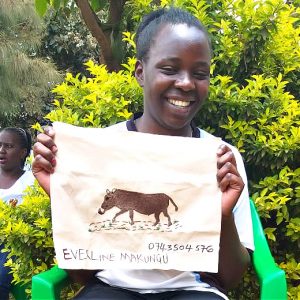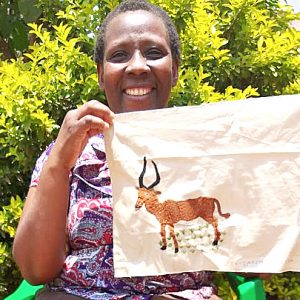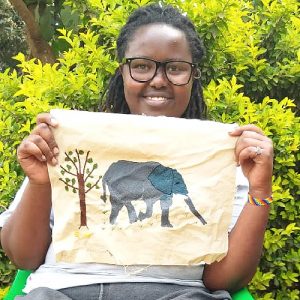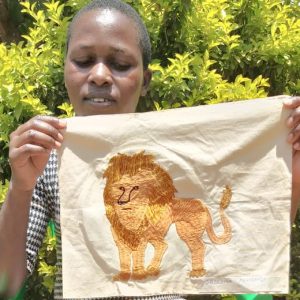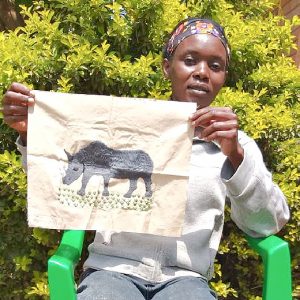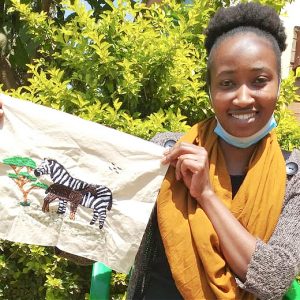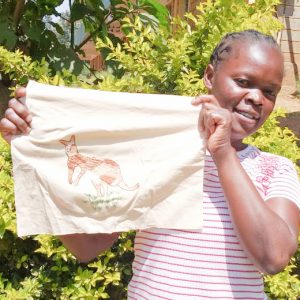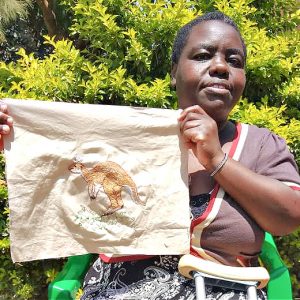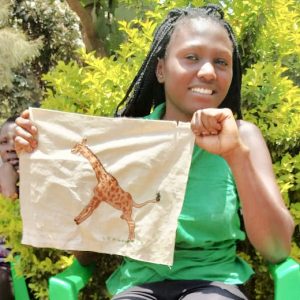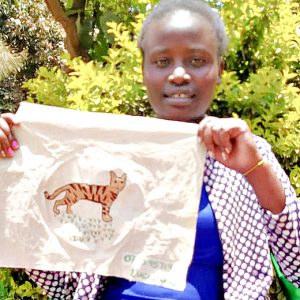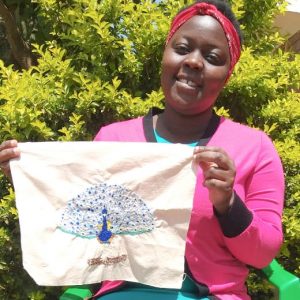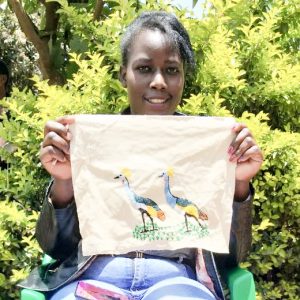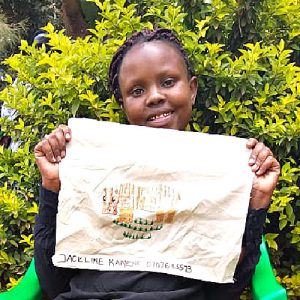Sister Artists Kenya Quilts
Background
The quilt auction is now closed.

Sister Artists 2 is our second quilt initiative to connect fiber artists in the Global South with quilters in the North. It is built around 41 embroidered animal designs that were made at the height of the pandemic by women in the informal settlements of Kibera and Kangemi, in Nairobi. The participating partners in Kenya are the Tandaza Trust (Kibera) and the Kangemi Advocacy Self-Help Group.
We first met the Kenyan sister artists when they produced embroidered stories for the Women’s World Quilt in Nairobi in November 2019. Many are single mothers and were struggling even before the pandemic. COVID-19 has added greatly to the pressure.
In 2021, the blocks were turned into quilts by art quilters from North America, who are profiled on the third tab. The quilts were exhibited at The textile Museum in Washington DC in 2022 over a period of two days and offered for sale through an online auction which fetched $11,150. Friends also donated another $595. As with Sister Artists 1 (Mali) we also produced a catalogue of the Kenyan quilts which sold well.
All of the profits from this successful program has been invested back in the Kenyan artists. The bulk of the money went to supporting composting in the settlement of Kibera, Nairobi. We also supported a COVID-19 vaccination campaign by the Kangemi Advocacy and Self-Help Group.
The two Sister Artists projects have provided many important lessons and shown that stitching can be an important force for empowering women and triggering social change.
Making their blocks for the quilts contributed to the well-being of the artists during a terrifying time. First, it gave them a creative outlet for anxiety. Meeting regularly for trainings – in the open air and wearing masks – allowed them to socialize with friends after weeks of lock-down. Several made friends with the sister artists in the north who worked on their blocks.
The project also helped to build social capital. Keen to keep up the momentum, Caren Mbyaki, who coordinates the Kangemi team, created an WhatsApp list to allow members to remain in touch and this has given them another emotional lifeline during the pandemic. They have used it to encourage each other with quilt designs, offer consolation in times of loss, and generally keep in touch.
Late in 2020 the Kenyan sister artists signed up for AP’s global program to tell their story of the COVID-19 pandemic through embroidery. They produced wonderful designs which were assembled into three spectacular quilts in the US.
Caren was so impressed by her team’s enthusiasm that she registered the group as an association with the government, in the hope that they could advocate for better services in the overcrowded Kangemi settlement. This is exactly what has happened. One of the COVID quilts has been sent back to Nairobi, where it helps the team to make the case for vaccinations in the settlements.
In Kibera, Stella Makena had created a new association, Shield of Faith, to organize stitching training. The group has stayed together and launched a composting revolution in what has been called Africa’s largest slum.
We are grateful to the sister artists from Kenya and the North for providing their profiles for these pages. Our thanks as well to Gill Rebelo, Sigrun Hansen and Bobbi Fitzsimmons for their tireless work and encouragement, and to Humanity United for its generous financial support.
Questions? Contact Bobbi Fitzsimmons: bfitzsimmons@advocacynet.org
Embroidered Blocks
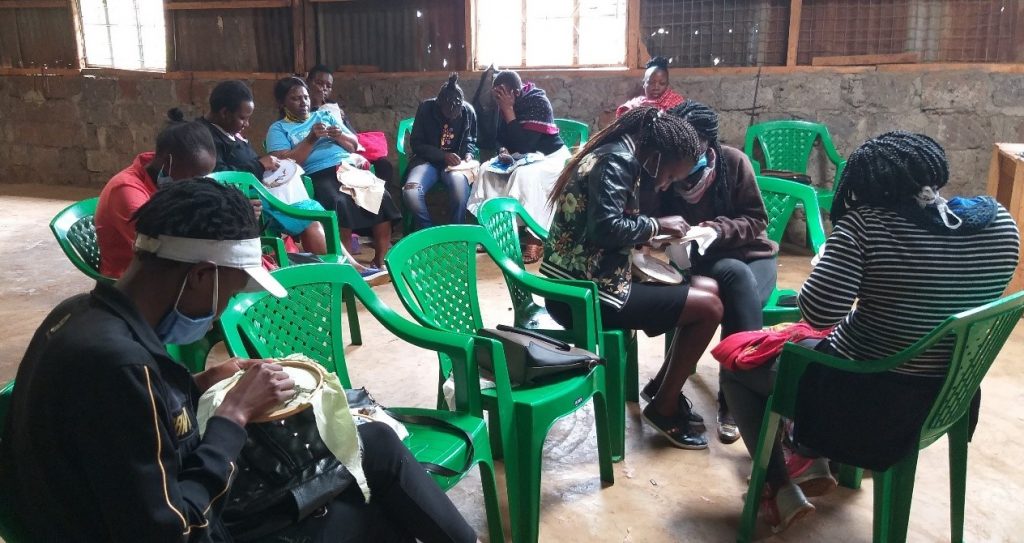
The artists from Kangemi and Kibera wore face-masks and observed social distancing when they gathered for a group training, and welcomed the opportunity to work with their friends while making their blocks. Each block features wildlife from Kenya and was made to serve as the foundation for an art quilt. The average size is 14″ by 12″. Profiles of the artists can be found on the last two tabs.
|
|
|
|
|
|
||
|
|
|
|
|
|
|
Sister Artists from the North and Their Quilts
Fire Finches
Judy Miller
Moraga, California
Judy was delighted to receive Stella Makena’s embroidered piece. It is masterfully stitched and Judy was determined to give it a setting that showcased its beauty and personality.
Putting marks on fabric, whether with paint, dye, or thread, brings Judy joy and her quilt incorporates several of these techniques. She drew the central piece and then used water color to create a setting for the red bird. Judy then added touches of embroidery to link to the original piece. The borders are hand-dyed linen. Judy used hand and machine stitching for the final quilt.
“Though Kenya and California are a world apart, they have been joined by art and a love of craft,” Judy says. “I am honored to have shared this adventure with my sister artist.”
Crocodile and Eagle
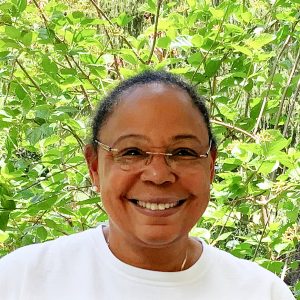 Juandamarie Gikandi
Juandamarie Gikandi
Princeton, New Jersey
Juandamarie started quilting 15 years ago. She is the founding President of the Princeton Sankofa Stitchers Modern Quilt Guild and her quilts have been widely exhibited including at the Ellarslie House/Trenton Museum, the Montclair History Center, venues in Boston and on Martha’s Vineyard and the Response to Gee’s Bend exhibition at Swarthmore College.
Juandamarie was excited to participate in Sister Artists 2. She has traveled to Kenya numerous times and felt honored to have been paired with Caren Mbyaki, who led the Kangemi team. ”I’ve had the delight of corresponding with Caren,” Juandamarie reports. She looks forward to collaborating on future projects.
Juandamarie used African fabrics to represent the water and the habitat of the crocodile in this block. The quilt is machine pieced and machine quilted with free-motion details to enhance the embroidery.
The Finest Rhinoceros
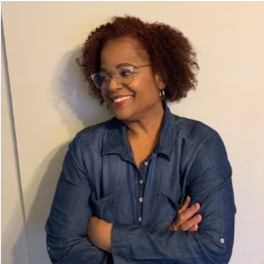 Veronica Mays
Veronica Mays
Portsmouth, Rhode Island
Veronica has been quilting in earnest for five years and gave up teaching in the summer of 2019 to quilt full-time. She runs her own company, Conaky’s Quilt Company, and produces vivacious quilts, usually in an African style.
The Finest Rhinoceros is built around a beautiful hand-embroidered centerpiece and surrounded by rich border-stripe fabrics featuring African animals. Veronica used machine stitching, cotton fabrics, batting and thread. It’s a blessing to collaborate with such a talented sister artist!
Veronica is a member of two guilds in Rhode Island – Quilters by the Sea and Rhode Island Threads – as well as Studio Art Quilt Associates (SAQA).
Ostrich
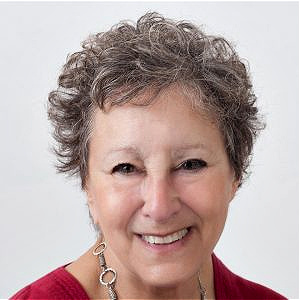 Deborah Weir
Deborah Weir
Rolling Hills Estates, California
Deborah is a mixed media artist, although she mostly works with textiles. Though contemporary in every sense, her art owes much to traditional “women’s work” and is done mostly by hand using a needle and gentle materials such as thread, floss, and beads. Deborah also uses more modern, edgier materials such as Tyvek, Fosshape, and even objects that she finds.
Deborah’s artwork is detailed. It often relies on reflective surfaces and tiny, rich elements, and does not always neatly fit typical categories. She uses collage, 3D and heavily worked or embroidered surfaces as well as art quilts and weaving.
Deborah loves the process of making quilts, but her work is always driven by an idea. Her recent art has explored issues of incarceration and she has depicted prison cells that draw from photos she took at Alcatraz. Her current project involves 3D images referencing Paleolithic cave mark-making.
Ostrich is surrounded by bright fabrics that have been fused together in free-form pieces. Deborah then quilted around many of the small pieces to ensure their stability. She added the ostrich’s tail of white feathers and included a stabilizer inside the quilt to ensure that the feathers are not bent. The quilt also has machine piecing and quilting.
Deborah has shown her work on six continents and curated over a dozen art exhibitions. Her art has appeared in journals online and in print. She is delighted to be involved with The Advocacy Project! See more of Deborah’s work at https://www.deborahweir.net/
Warthog on the Move
 Carol Churchill
Carol Churchill
Los Alamitos, California
Carol Churchill grew up in Southern California. She practiced law for 30 plus years, then joined two textile art groups: Quilts on the Wall Textile Artists and Studio Art Quilt Associates (SAQA).
Carol loves to travel around the world, taking photographs and visiting art galleries. She put Kenya on her must-see list and, during her visit, was lucky to see warthogs running across the hot dry African landscape wagging their tails in the air. It was an amusing sight!
Carol chose Everline’s warthog because it brought back wonderful memories of her visit to Kenya. She opted for background colors that match Everline’s embroidery and theme, and then wove gold metallic threads loosely across the top. Finally, Carol added glass beads to create texture and give an impression of heat from the African sun.
Carol’s art projects have been published in Quilting Arts Magazine and the Art Quilting Studio Magazine. Her quilts have been exhibited at many shows and art galleries across the United States. Carol is chair of the Exhibit Committee for the Quilts on the Wall guild in Seal Beach California, and as such has organized the artwork of members into themes: Sunrise/Sunset, Life’s a Beach, Heat, Ice/Cold/Frozen, Fiddling with Fabric, to name a few. View the guild’s spectacular galleries here.
Thomson Gazelle
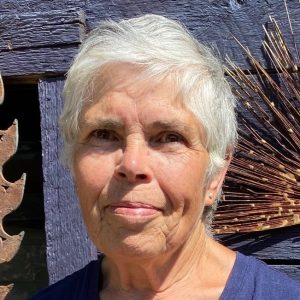 Nairn Stewart
Nairn Stewart
Denman Island, British Columbia, Canada
Nairn began quilting in 1989. In the early years she was self-taught but has since learned much from attending inspiring workshops. Prior to Sister Artists 2, Nairn had only done hand quilting and is relatively new to machine quilting. As a quilter it is always good to have a new challenge!
When planning her design for Thomson Gazelle, Nairn’s first goal was to enhance and complement the lovely embroidery. Her quilt features many different sections of patchwork, from tiny squares to little circles, that are all pieced by machine. The quilting is done by machine in free-motion style.
This is Nairn’s second entry to a Sister Artists project. She is very happy to be involved in an endeavor aimed at improving the lives of her sisters around the world.
Hope for Rhinoceros
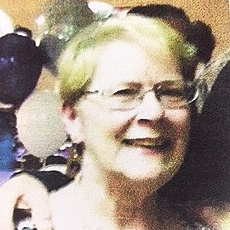 Peg Sullivan
Peg Sullivan
Rutland, Massachusetts
Peg has been quilting and teaching for over 30 years. She contributed to Sister Artists 1 (Mali) in 2018 and continues to be inspired by the incredible work of her southern sisters.
In designing her quilt, Peg contacted Spencer, her Kenyan sister artist and researched Kenya’s famous Lake Nakuru. This allowed Peg to depict a lake in her quilt. She sent photos of her quilt to Spencer and truly hopes that she is pleased with the result.
In her quilt, Peg used photo transfers to complement the rhinoceros. She used fabric from her collection of African prints to represent the vibrancy and beauty of the continent of Africa and the machine piecing is done with different African fabrics. Peg then used big-stitch hand embroidery to further embellish the quilt which she then machine pieced.
Peg has worked with many young Africans in her career as an educator in nursing. She says that being part of Sister Artists 2 is an honor and hopes that her contribution will assist more women to participate and grow in the hobby that she loves. Quilting is a very large part of Peg’s own identity and a source of peace, pride, and satisfaction which helped her to survive throughout the pandemic.
Water Buffalo
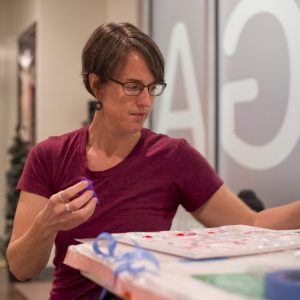 Jessica Arends
Jessica Arends
Hyattsville, Maryland
Most of Jessica’s experience is with drawing and painting and she drew on both these skills to make her wonderful quilt.
Jessica visited Kenya in 2013 to volunteer with a youth-empowerment center for homeless children and teens. She drew on this experience in making her quilt and tried to capture the feel of the expansive Kenyan sky and landscape. The experience taught Jessica that young women can be strong and resilient. The two figures in her quilt honor those she met during that visit.
Jessica has chosen a color palette to match the fabrics she brought back from Africa and uses the fabrics in the two figures at the bottom. She placed the water buffalo at the center of her quilt to honor the embroidery skills of her Kenyan sister artist, Betty Namalwa, and used intricate and innovative piecing to make the sun. She used a combination of raw-edge applique and machine piecing to make her quilt, which is machine-quilted.
Jessica hopes her quilt will bring joy to its new owner and further the important mission of AP.
Hyena on the Hunt
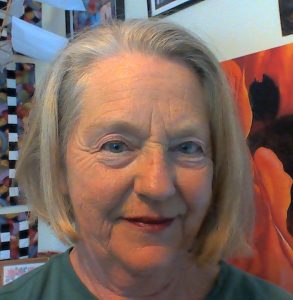 Victoria Rugo
Victoria Rugo
Wilmington, North Carolina
Victoria describes herself as 65 years young and retired. She likes to sew, read, travel, and volunteer.
Quilting is part of Victoria’s family heritage. Her grandmother used a treadle-foot sewing machine. Victoria herself has been sewing since she was eight, and quilting since she was 18. Her mother taught Victoria and her three older sisters to sew on a Singer machine when Victoria was eight. Both of her daughters can sew and quilt and they all made fabric face masks this year.
Victoria enjoys people, art – and mixing fabrics and colors. She finds hand quilting very relaxing and likes to use natural fabrics like silk and cotton. She has made – and given away – many quilts. Victoria completed Hyena on the Hunt almost entirely by hand. She chose fabrics and colors to reflect and complement the embroidered hyena.
Victoria supports The Advocacy Project because it helps women all over the word who need assistance.
Sunshine on Kenya
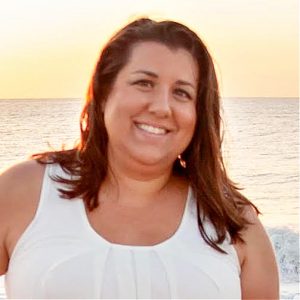 Christine Danler
Christine Danler
Wilmington, North Carolina
Christine has been quilting for over 20 years. She remembers how her mother’s quilting bee met every other Thursday and how she socialized with the ladies every time it was hosted at her house: “My mom was very involved in the bee and guild, and I was always interested in the arts. But I didn’t really take an interest in quilting until I was in my twenties.”
Christine was attracted to Sister Artists 2 after seeing the amazing quilts that came out of the first Sister Artists project: “The design for my quilt was inspired by the baobob trees in Africa, which you think about when picturing the African grasslands. I thought, “Well, the baobob tree is pretty cliche, so let’s jazz it up a bit with this funky fabric, to really give it a nice alternative to some more traditional landscape scenes!”
In the upper left corner, you can see some decorative stitches that depict a sun spreading its rays over the tree. An outline of Kenya is quilted into the background to the left of the tree trunk. Decorative ribbon outlines parts of the background blocks.
Christine wanted to keep the quilting simple so as to not take away from the embroidered rhino. She really enjoyed working on this project, and wishes the embroiderers the best of luck!
Queen Mother
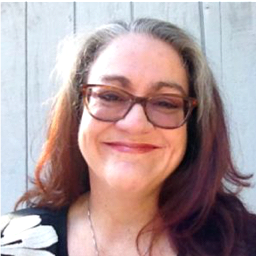 Julie Zaccone Stiller
Julie Zaccone Stiller
Boulder Creek, California
Julie took art training while at university in California. She is particularly interested in women’s issues and took part in Sister Artists 1 (Mali) because she was drawn by the cause and hoped to make a connection with women in Africa.
Julie chose one of the embroidered lions for Sister Artists 2 (Kenya). She created intricately-pieced borders that play off the colors in the embroidered block. She used African fabrics and applied free-motion quilting.
Julie is a member of Studio Art Quilt Associates (SAQA); the Modern Quilt Group; Contemporary Quilters; and Fiber Artists in the Bay Area.
Crested Cranes
Elephant Walk
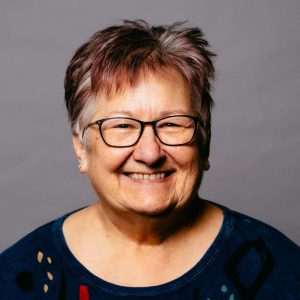 Glenda Mah
Glenda Mah
Salem, Oregon
Glenda is primarily a Shibori textile artist and also enjoys collage quilting. She tries to incorporate naturally-dyed fabrics into her pieces and especially indigo.
Glenda draws heavily on the natural world for her art and tries to make a statement with each piece. She is also drawn to creating pieces that highlight social issues. Glenda sews for the Social Justice Academy, an organization that creates memory banners for victims of violence. Her piece “Roots” was selected by the Artists Against Racism and was also displayed as part of the exhibition series Art & Social Justice: Art for the People by the People at the Ellington-White Contemporary Gallery in Fayetteville, NC.
Glenda is so glad and honored to be part of Sister Artists and The Advocacy Project. She hopes her use of the block by her sister artist Harriet Njeri Kariuki brings joy. Glenda incorporated fabric that she mud dyed with a print design and highlighted the colors in the block by using colorful batiks. She used a simple geometric quilting pattern so as not to draw away from the fantastic embroidery panel. There is hand-painted and hand-stamped fabric in the borders. The quilt is machine pieced and machine quilted.
Glenda is a member of the Mid-Valley Quilters Guild in Salem, Oregon and belongs to a wonderful sewing group called the Knotty Stitchers.
Sunrise at the Watering Hole
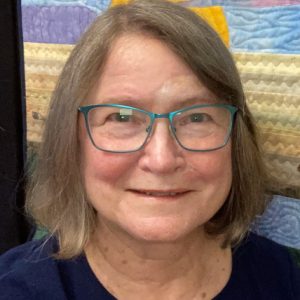 Bobbi Fitzsimmons
Bobbi Fitzsimmons
Wilmington, North Carolina
Bobbi has an EdD in education and has been an early childhood educator for years. She began sewing at an early age, making most of her own clothes until she found quilting in her 20’s. From that point forward, she combined her love of working with young children and her passion for quilting. She has used her quilts to share many valuable lessons with children, such as the importance of persistence and the joy of sharing with others.
Bobbi coordinates all quilting initiatives for The Advocacy Project. In this position, she helps women and girls from the Global South to tell their stories though embroidery and connects them with quilters who turn the stories into finished quilts. Bobbi recently spearheaded an exhibit at the Cameron Art Museum in Wilmington, NC to showcase COVID quilts from Nepal, Zimbabwe, and the US. Sister Artists 2 is the latest project she is coordinating.
After the Kenya animal embroideries were selected by the sister artists, one block remained and Bobbi took this to make her own quilt. Having visited Nairobi in November 2019 and helped these same ladies complete The Woman’s World Quilt, Bobbi decided to reflect the landscape of Kenya. She used both subdued and vibrant colors of Africa in her design, and drew on one of her favorite issues – protecting the environment – by showing Elizabeth’s antelope going to the water hole. She hopes her Kenyan sister artist will approve.
Bobbi’s quilt uses several different methods of piecing: hand-pieced octagons, strip piecing, and raw-edge applique. There is some unique open-work near the bottom border which frames strands of African style beads. The border is African fabric and the piece is machine quilted.
Bobbi is a member of Swan Lake Quilt Guild (Sumter, SC) and Quilters By the Sea Guild (Wilmington, NC).
Born to Be Wild
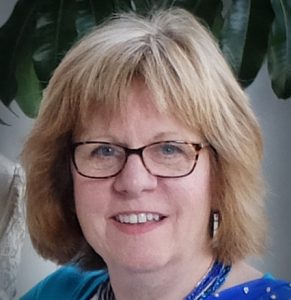 Mary Harned
Mary Harned
Wilmington, North Carolina
This hippo block was embroidered by Jackeline Kamene of the Kangemi community and turned into a quilt by Mary in North Carolina. Mary learned quilting from her sister and has been quilting for 10 years. The two sisters enjoy quilting together and invite you to visit their projects on their blog: www.quiltingsistersunravelled.com
Mary was introduced to The Advocacy Project by Bobbi Fitzsimmons, who was a Board member of her guild. She loves making fabric art wall hangings and is always experimenting with new techniques. Creating fabric art for a good cause and enriching someone’s life in the process is one of Mary’s favorite things to do.
Mary was happy to receive her block and was attracted to the hippo’s sweet face. She surrounded the block with wonky log cabin blocks and added a little hand stitching around the hippo for some additional texture. The color scheme represents the water, grasses and the land. The top border fabric (village print) was donated by a fellow quilt guild member and provided just the finishing touch this quilt needed.
Mary loves a challenge and this one was extra special. It was an honor to highlight such beautiful embroidery work.
Playful Monkey
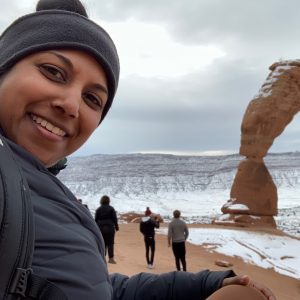 Aarti Ravi
Aarti Ravi
Washington, D.C.
Aarti started quilting in 2019 when she decided to make two quilts for babies and she hasn’t stopped since. Aarti recently started making garments as well.
Aarti learned about Sister Artists 2 through a fellow member of the DC Modern Quilt Guild and was drawn to the project and the amazing blocks from Kangemi and Kibera.
In working on her beautiful block from Africa, Aarti wanted to play off the colors and elements chosen by Pauline, the artist. She decided to add the green and orange frame, and then added paper-pieced leaves. Describing her quilt she states, “I love the precision of paper piecing and the complex elements you can create.”
Aarti has been in touch with Pauline and loves the fact that Pauline says she can see herself improving, just as Aarti finds herself learning new techniques with each quilt she makes. The quilt is finished with both hand and machine quilting.
Snake in the Grass
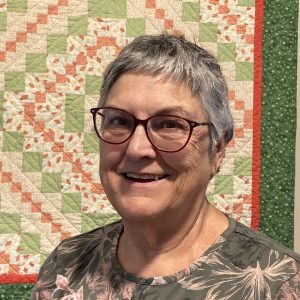 Anne Watson
Anne Watson
Wilmington, North Carolina
Anne was born in England and learned to sew at an early age. There was no television, only radio at the time and her aunts would listen to the radio while they did their knitting, quilting, embroidery, and tatting. Anne was encouraged to sew along! Sewing at school was also part of the school curriculum. Anne had to take out the stitches on her first knitting project so many times that the yarn turned from light pink to dingy grey!
Quilting became an interest in the late 1960s when Anne came to America. She enjoys art quilting and experimenting with textures. Her first quilt was a block-by-block by Georgia Bonesteel and she progressed from there. One of her more recent projects is a COVID-19 quilt for The Advocacy Project that was assembled from blocks from Nepal.
Snake in the Grass is built up around an embroidered snake by Maureen in Kenya. In designing her quilt, Anne has added a second appliqued snake. In terms of material, Anne used a significant amount of bead-work and ran a hemp-like cord around the edge. She used machine piecing and raw-edge applique throughout. The quilt is machine quilted.
Rest by Day – Hunt by Night
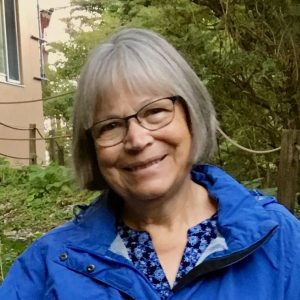 Ellen Fisher
Ellen Fisher
Hollis, New Hampshire
Ellen learned to sew as a child, mostly clothing and practical items. Inspired by her mother’s quilts, she has been quilting herself for about 20 years. Since her mother had made so many wonderful bed quilts for the family, Ellen tried smaller pieces.
Ellen’s background is in drawing and graphic design, and studying landscape architecture encouraged her to experiment with quilt designs. From that, it was a logical step into art quilts. Ellen’s quilts usually reflect her interest in plants or landscape.
This quilt is Ellen’s second Sister Artist project. “When I made the quilt with my Malian sister’s embroidery, I loved the challenge of collaborating with another artist to create a blending of our work,” she said. “I was eager to do it again with the Kenya project.”
Christine’s blocks shows a regal leopard lounging on the branch of a tree. Ellen did her research and found that this is a typical daytime pose for a leopard, which relies on cunning and the cover of darkness to catch its prey. “It seemed to me that encountering a leopard would feel very different at night than in the daylight,” says Ellen. “That inspired me to show the two faces of a leopard in this quilt.”
Ellen used raw-edge applique on both halves of this quilt and drew on thread painting to enhance the design. She also enjoyed expanding the landscape that is depicted so beautifully in Christine’s embroidery. The quilt is machine pieced and machine quilted.
Ellen is a member of Studio Art Quilt Associates (SAQA).
Sentinel
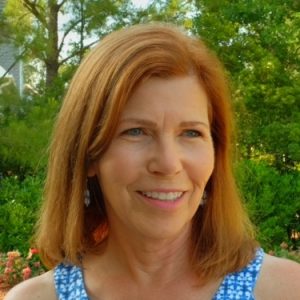 Lynn Flaherty
Lynn Flaherty
Wilmington, North Carolina
Lynn is a retired pharmacist, originally from New Hampshire. She took her first traditional quilting class in Massachusetts in the early 1980’s, before the birth of her second daughter. As a longtime seamstress, Lynn was intrigued with all the ways quilters were using fabrics and the endless possibilities. Hand appliqué and embroidery soon became her favorite techniques and she enjoys using many different textiles and fibers in her work.
Speaking of her experience with the project she says, “It was an honor to participate in the Sister Artists quilt project. I love that the Kenyan women are using embroidery as an art form and a means to improve their economic prospects.” Lynn’s vision for her leopard was to incorporate him in a Kenyan landscape, looking south toward Mount Kilimanjaro. She thinks of him as a guardian of his environment.
Lynn has incorporated the embroidered leopard into a complete African landscape using different beautiful fabrics. Nine-patch blocks surround the center of the quilt in coordinating colors. Lynn has also added several embellishments including silk ribbons and additional hand embroidery.
Playing in the Sunshine
This quilt was made jointly by Kathy Springer and Cathy Franks.
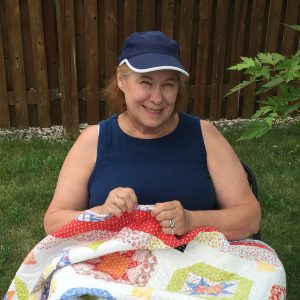 Kathy Springer
Kathy Springer
Westfield, Indiana
Kathy fell in love with quilting at a craft show in Maryland. Soon afterwards she made her first quilt with the help of a neighbor. Kathy has made many quilting friends in the years since and has collaborated with Cathy Franks who loves quilting as much as Kathy loves piecing! Together, they and others have made several quilts for The Advocacy Project including the tragic but beautiful Rehema Widows Quilt. She has also worked on the Moroccan Amazigh Quilt and the Women’s Microcredit Quilt from Bangladesh.
When contacted about the Sister Artists Kenya project, Kathy selected the playful giraffe by Penninah. She wanted to highlight the giraffe, and felt a wall hanging that could go anywhere in a house, a child’s room, a nursery, etc. would be perfect. She used Electric Quilt to design this quilt as she knew the sun block would have to be paper pieced, as well as the trees.
Kathy already had some fabric that carried the designs of a giraffe, elephant, etc. and had colors that were vivid and bright like Penninah’s giraffe. Kathy used these for the quilt. The quilt is machine pieced with precise paper piecing on the trees and the sun. Machine quilting has been used throughout.
Kathy has just recently retired and become a grandmother. She feels lucky that she can watch her grandchildren and spend a lot of time creating quilts, as this is truly her passion.
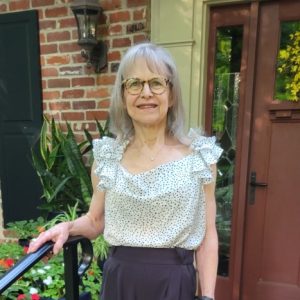 Cathy Franks
Cathy Franks
Carmel, Indiana
Cathy has been quilting for the last 40 years. She has had her own custom machine-design quilting business for the last 30 – 35 years. Cathy has been fortunate enough to have been able to teach in almost all 50 states of the USA and also in several foreign countries. She has also been published in numerous magazines and has appeared in several quilting programs that are aired on the internet and also on TV.
Cathy loves meeting new people and is happy to share any information she has about quilting with everybody she knows. Quilting has been a wonderful and joyous experience for her. Her lovely quilting highlights Kathy Springer’s design. Cathy wants to thank The Advocacy Project so much for taking on this project and all the work and effort that has been put into it.
Graceful Gazelle
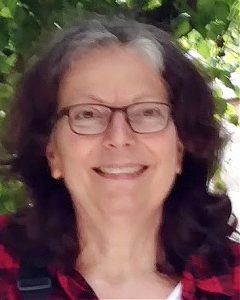 Linda Warschoff
Linda Warschoff
Silver Spring, Maryland
Linda’s mother taught her to sew when she was a young child. When she was in her 30s, Linda had a moving and painful experience and wanted to express this a quilt. She had no idea how to construct a quilt and took a studio class where she learned the basics of patchwork and applique. Linda has been making quilts ever since with some breaks along the way.
Although Linda has made quilts with traditional blocks and patterns, she is mostly an improvisational quilter. The composition of a design is particularly important. Linda usually modifies, expands, takes detours and allows serendipity to happen as she works on a quilt or wall hanging
Over the years, Linda has had several opportunities to collaborate with artists in other parts of the world. In Sister Artists 2 she saw another chance to put the slogan “sisterhood is powerful” into practice. In this collaboration with Florence Wangu, her Kenyan sister artist, Linda placed the gazelle in the savannah, its natural habitat. Florence embroidered the gazelle and much of the grass below it. Linda supplemented this with more grass and put in the wavy and couched lines above it. The backside and binding on the quilt are made from fabric given to her by a friend who had purchased it at a market in Nigeria (although Linda thinks it may have been produced in Indonesia—another example of our interconnected world!)
Buffalo
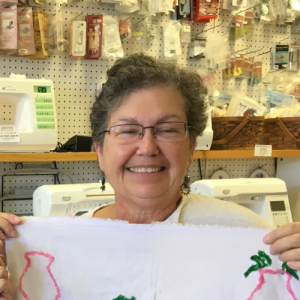 Merry May
Merry May
Tuckhoe, New Jersey
Merry May has lived in Tuckahoe, NJ for most of her life. She has been making quilts since the early 1970s, and became a quilting instructor in 1988. She is also a lecturer, designer, author, quilt historian, curator, mentor, and fabric & button hoarder. Merry has designed and written instructions for over 40 patterns of Merry Mayhem’s Mystery Quilts, which have been enjoyed by quilters worldwide since 1994. Her work is in public and private collections worldwide.
Merry has made several quilts for The Advocacy Project. Her most recent two quilts include blocks by Middle Eastern refugees from Iraq, Syria and Palestine (the Fifth and Sixth Middle Eastern Refugee Quilts).
The setting for Buffalo was machine pieced with many different fabrics including African and African-inspired ones. Most of the quilting is done by machine except for the water, which is hand quilted using a variety of thread colors as well as metallic gold. The colors of the original embroidery are reflected in the colors of the border. Merry has used a variety of embroidery stitches including couching, some of which are used for quilting as well.
In Merry’s “spare time” she manages a local cemetery, and owns two tons of buttons (no, really!). Merry is Past President of the Greater Tuckahoe Area Merchants’ Association, and established the Association’s annual Handmade in America Professional Craft Show in 2014. More of her work can be found at: www.MerryMayhem.com.
Kenyan Lion King
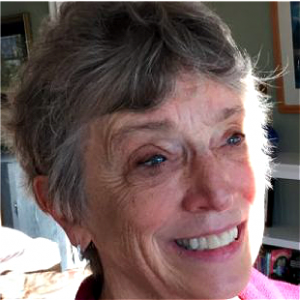 Hope Barton
Hope Barton
Brooklyn, Connecticut
On a trip to the Serengeti, Hope and her group were taken to an area known for having lions that lived on the top of very high rocks. They were told that that animators for the movie The Lion King had come to the area for the inspiration for the famous opening scene.
When Hope saw the beautifully hand-embroidered lion done by Modester Makhungu, her Kenyan sister artist, she knew immediately how she wanted to design her quilt.
Hope used raw-edge, machine appliqué to create the massive rock where the lion is standing. The sky is made of hand-dyed fabric. The machine quilting also includes some thread painting.
Hope is a long-time quilter. After blanketing her family, friends and new babies with quilts, she turned to the fun of making art quilts. This is Hope’s second quilt for The Advocacy Project.
Hope has been a long-time supporter of women’s rights and spent most of her working life as a nurse practitioner for Planned Parenthood. A mother of five, Hope has five grandchildren.
Protecting Her Pride
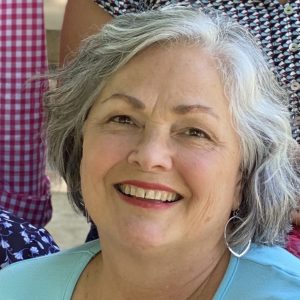 Pati Fried
Pati Fried
Piedmont, California
Pati has been quilting for almost 30 years. Her background is fabric and graphic design. After teaching and blogging for many years, she found her passion in supporting others in their creative endeavors and by making her own meaningful art (which just happens to include textiles!)
Pati’s quilt was inspired by the Kenyan artist, Evelin Ndanu. Pati compares Evelin and her young child to the lioness and her offspring – both are trying to protect those they love. The children in Pati’s piece were inspired by a photo she found while researching Kangemi. They appear to be protecting each other, just as the lioness protects her pride.
Pati stitched her quilt entirely by hand, except for the finishing of the edges. Fabric was torn to give a soft, natural fray, layered and collaged, then stitched together with an assortment of threads to add texture and movement. This is a process Pati has been exploring over the past few years. “I find it to be similar to freely painting and sketching for me, as opposed to the rigidness of stitches made by machine,” she writes.
Pati does very little pre-planning when using this technique which involves making choices in the moment, whether in layering the fabric or accentuating the stitches. It is a liberating process, somewhat like doodling. The quilt is meant to be enjoyed up close.
Pati’s work can be seen at Patifried.com and SeeHowWeSew.com.
Wildcat
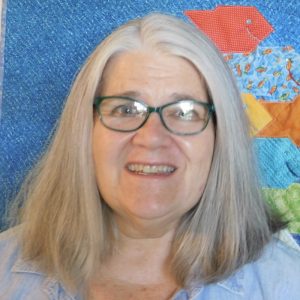 Jane Cancellieri
Jane Cancellieri
South Dennis, Massachusetts
While researching potential speakers for her quilt guild, Jane happened to find Allison Wilbur’s Quilt for Change website and and announcement of the Sister Artists 2 project. The Kenyan embroidery reminded Jane of story cloths created by the mothers of immigrant Hmong children she had taught in the 1990’s and 2000’s. The beautiful embroidered Hmong story cloths chronicled the lives of the Hmong clans – from villages in the highlands of Laos and Vietnam, to the refugee camps in Thailand and eventually to new homes in the United States.
With her new-found collage quilting skills, Jane knew she wanted to be involved with Sister Artists 2.
Jane learned to sew as a youngster at the elbow of her grandmother, making clothes for her dolls. She spent her teenage years repurposing denim jeans into new garments. In college and beyond, Jane designed and constructed formal dresses and gowns for proms and weddings. Between raising a family and teaching middle school students science in an urban school district, Jane could be found designing, sewing and altering bridal and special occasion gowns. This grew into a small side business.
After retiring from teaching and fancy gown making, Jane had time to learn quilting, which has become her passion! During this past year of the pandemic, she has been able to learn quite a few new quilting techniques via YouTube videos and Zoom workshops. Her latest favorite technique is art and landscape collage quilting.
Reflecting on Wildcat Jane says, “It has been my honor and pleasure to participate in this Sister Artists 2 project!” She placed the embroidered block in a realistic setting using raw-edge applique and raw-edge piecing. The quilt is machine pieced and machine quilted.
Jane is a member of Bayberry Quilters of Cape Cod.
Zebra
 Karen Pulaski
Karen Pulaski
Hudson, Massachusetts
Along with creating art quilts, Karen enjoys bringing the pleasure of quilting and sewing to students of all levels. Karen brings 40+ years of sewing experience to all who join her class. She has had several articles written about her quilts in various newspapers, including the Boston Globe and Arts Around Boston magazine.
Karen has used African fabrics to set off the realistic zebra embroidery. The quilt is machine pieced and machine quilted.
Grazing Giraffe
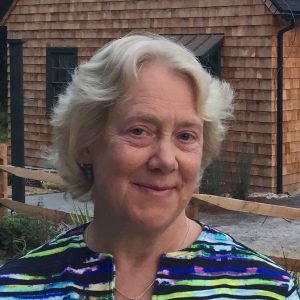 Tricia Deck
Tricia Deck
Lincoln, Massachusetts
For Tricia, quilting is part of a larger creative process that includes photography. It all comes together in Tricia’s quilts and she looked on Sister Artists 2 as an opportunity to experiment with new approaches. Tricia knows Africa from visiting Zambia and was impressed when a friend started an education fund for young Africans.
Tricia has made quilts for fund-raising and was drawn to Sister Artists 2 because she wanted to help. She picked the giraffe block because she finds giraffes majestic and thought the giraffe embroidery was beautifully crafted. The piece-work in this quilt reflects and enhances the colors of the original block. Tricia used some African and African-inspired fabrics and has machine pieced and machine quilted her quilt.
Tricia is a member of Studio Art Quilt Associates (SAQA); the Quilters Connection Guild, based in Watertown; and the Rising Star Quilt Guild in Arlington. Tricia sells her work through galleries and takes on commissions.
Zebras
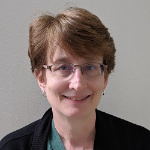 Rhonda O’Keefe
Rhonda O’Keefe
Hudson, New Hampshire
Zebras is Rhonda’s second quilt for The Advocacy Project – she also participated in Sister Artists 1 (Mali) in 2020. Rhonda was especially happy to get the embroidered zebras to work with after finishing another art quilt with zebras.
Zebras was a particular challenge because Rhonda suffered a stroke just after receiving the beautiful embroidered square. She planned the quilt while spending a week in the hospital and another week in rehab, learning to use her left leg, arm and hand again. She viewed working on her quilt after she returned home as a part of her therapy.
Rhonda continues to recover coordination and strength, and has resumed work part-time as Director of Environmental Health and Safety for the Broad Institute in Cambridge, MA. She lives with her husband and dog, and in her spare time enjoys making art quilts and bed quilts, gardening, hiking, and ringing hand bells.
Zebras is set in a brilliant array of oranges and reds to represent the African sun. Rhonda has added sunshine quilting motifs inside one of the yellow rays. This quilt is machine pieced and machine quilted.
Simba Jasiri – Brave Lion
 Stephanie Adams
Stephanie Adams
Bethesda, Maryland
Stephanie is a public health management consultant. She has been quilting for four years and is a member of the DC Modern Quilt Guild. Stephanie has always dabbled with crafts and when her best friend of 45-plus years pushed her into an Internet rabbit hole Stephanie found inspiration from phenomenal quilters – Chawne Kimber, Jacquie Gering, Bisa Butler, Gee’s Bend and so many others. She hasn’t looked back since and is inspired by the way quilts can make powerful political and social statements. After a dear friend invited her to an exhibition of the first (Mali) Sister Artists quilts in Washington, Stephanie was inspired to support the phenomenal work of The Advocacy Project and join Sister Artists 2.
In making Simba Jasiri – Brave Lion, Stephanie wanted to provide a simple backdrop to highlight the extraordinary embroidery by Susan, the lion’s majestic strength and bravery, and the beauty of the savanna. She used wool batting and dense, wavy quilting to make the lion pop out in a dreamy, undulating landscape. This dramatic presentation uses black-on-black fabrics which make the silver lamé moon shine even brighter. The multitude of yellow fabrics surrounding the lion embroidery also provide an artistic contrast. The quilt is machine pieced and machine quilted.
Feathers and Flowers
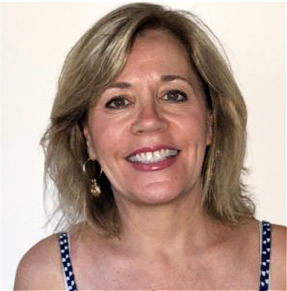 Diane Clapes
Diane Clapes
College Park, Georgia
Diane has always loved working with fabric. She “dabbled” at quilting while raising a family, but turned to quilting full-time when her last child went to college. Diane likes art quilting “because I don’t have to follow a pattern and can be more individualistic.” She still takes classes and has had several quilts hung in shows.
Diane was honored to work with Diana Adeya’s peacock block. She found the workmanship spectacular and loved Diana’s colors, which gave her inspiration for her portion of the quilt. Diane used Diana’s colors and worked with flowers and leaves that she had drawn to create a whimsical framing of the beautiful bird. The flowers surrounding the embroidered peacock use an applique technique in which each flower is outlined with fine, contrasting fabric and then machine quilted. The applique is raw-edge. The quilt is machine quilted.
Diane is a member of the Studio Art Quilt Associates (SAQA).
In the Shadows of Menengai Crater
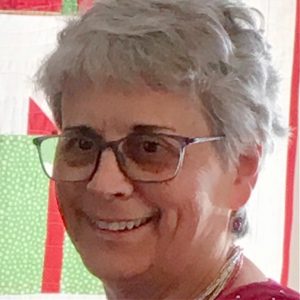 Donna Bergman
Donna Bergman
Wilmington, North Carolina
Donna became interested in working with textiles when she started sewing garments as a teenager. When she was 18, Donna made her first bed quilt using scraps of fabric from her mother’s stash of garment fabrics. Despite making lots of mistakes on that first quilt, she continued to make bed quilts and has sewn garments for about 30 years.
When Donna retired from teaching children in elementary schools about 10 years ago, she started taking classes to learn more quilting techniques, especially for making art quilts. She was inspired by photographs from travels to make landscape quilts and likes to experiment with different techniques such as painting and dyeing fabrics and adding mixed media elements.
Donna likes to participate in challenge quilts to get her creative ideas flowing, and enjoys making quilts for different charities like Quilts of Valor, Habitat for Humanity, and Quilts for Kids.
Using photographs of Kenya and the Menengai crater as inspiration, Donna created a landscape background for the elephant embroidery made by Sabina in Kenya. Donna used fused strips of fabric to create the background and Angelina fibers on the crater. The trees are appliquéd to the background using free-motion quilting. Donna used raw-edge piecing and appliqué for this design, then used a combination of straight-line quilting and free-motion quilting to finish it. Hand painted fabrics, as well as shimmering fabric and silver thread on the snow-capped peak add realism.
Donna heard about The Advocacy Project through Bobbi Fitzsimmons at a Quilters by the Sea guild meeting in Wilmington, NC. Donna enjoys doing challenge quilts and was happy to support this important work.
Donna is a member of Quilters By the Sea in Wilmington, NC.
The Wildebeest Migration
 Sandra Cronauer-Mitra
Sandra Cronauer-Mitra
Somerset, Massachusetts
Sandra has been an avid quilter for almost 25 years. Although she first learned her craft in making garments, she has discovered that stitching traditional and art quilts is a very creative and challenging process. As a retired biologist and teacher, she frequently features animal and plant motifs in her work.
Sandra was so impressed with the level of craftsmanship in her embroidered wildebeest from Kenya that she initially hesitated to work on it. She was afraid that her contribution would detract from its beauty! After researching the ecology of the wildebeest, Sandra decided to focus on the annual migration of the animals. The regal embroidered wildebeest would lead the herd!
Dyeing fabrics is Sandra’s newest passion and she used her own hand-dyed fabrics in making the sky. The scene is constructed with batiks and commercially printed fabrics. By using a wool batting, Sandra was able to create the illusion of rolling hills with only a few stitched lines. She then used fusible appliqué to show a herd of wildebeest following the leader. There is intricate diamond piecing in the sky and significant machine quilting, as well as machine embroidery, throughout the piece.
Sandra has often thought of Patricia, her very talented sister artist in Kenya while the quilt took shape. She recognizes that Patricia is a true artist in every sense of the word.
Sandra is a member of Studio Art Quilt Associates, Rhode Island Threads and president of the quilt guild Quilters by The Sea, RI.
Ubuntu Crane
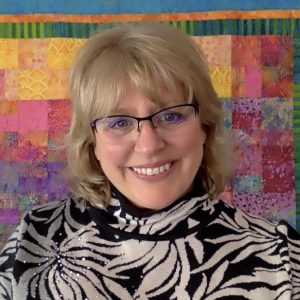 Dawn Piasta
Dawn Piasta
Dauphin, Manitoba, Canada
Dawn Piasta is an art quilter, graphic designer, pattern designer and motivational instructor from Dauphin, Manitoba, Canada. Her mother showed Dawn how to see the world with an artists’ eye when she was very young, and she continues to pursue her passion – playing creatively with fabric and paint – today. Art and quilting is therapeutic, relaxing, and brings Dawn a tremendous amount of joy.
This is Dawn’s second sister artists project and it comes after the COVID-19 pandemic. Dawn is reminded that people of Africa or African origin use the word Ubuntu to describe the values that make people authentic human beings. She tells us that living through the unrest and confusion of the pandemic was another reason to participate this second time around. Linking herself to this collective of creative women for a greater cause is, to Dawn, Ubuntu.
Dawn’s art draws on influences of family, travel, global awareness & social issues. Her art incorporates bold colors, graphic designs & interesting surface designs that highlight a variety of traditional and modern art forms. Dawn gave a lot of thought to the colors and symbols in her quilt. She used Adinkra symbols in her art-deco design; turquoise for wisdom, good fortune, and hope; and yellow for the sun for happiness and positivity. Dawn believes that “humanity should behave well towards others and act in ways that will benefit the whole of humanity.”
Dawn is a member and contributing exhibitor of the Fibre Art Network of Canada (FAN), Textile Fibre Artists of Manitoba (TFAM) and the Studio Art Quilters Association (SAQA) of Western Canada. She is also the Communications Director for the Canadian Quilters Association.
Beldine’s Lion
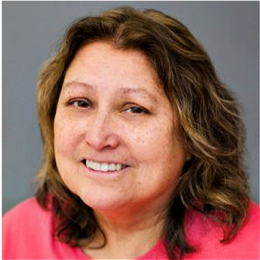 Cathey Labonte
Cathey Labonte
Moosup, Connecticut
As a full-time civil engineer, Cathey makes her quilts in her spare time. She learned quilting from her grandmother and mother, and moved into art quilting after her grandchildren were born. “Art quilting allows for more imagination, decoration and techniques,” she says. Cathey particularly likes working with colors.
Cathey created a block for Sister Artists 1 (Mali) and was one of the first to select a block for Sister Artists 2 (Kenya). She has used an interesting technique for this new quilt. She arranged loose pieces of fabric on a backing fabric, and then laid a neutral-colored netting over the loose pieces which she then quilted in place. A gauze-like fabric finishes the snow on top of the mountain. The embroidered lion blends seamlessly into the landscape.
Cathey is a member of the Narragansett Bay Quilt Association; the Quiet Corner Art Quilt Guild; and Studio Art Quilters Associates (SAQA).
Colors of Kenya
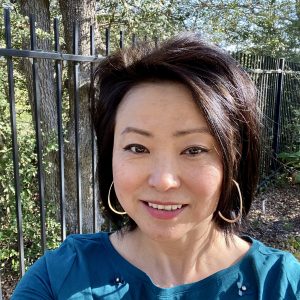 Linda M Kim
Linda M Kim
Austin, Texas
Linda brings a combination of passions to her quilting – textiles, found and recycled materials, and her identity as a woman, parent, immigrant and American. Every project is an opportunity to impart a message and create original work. So naturally, when she heard about Sister Artists 2, she got involved!
The lovely lilac-breasted roller bird embroidered by Caroline in Kenya inspired Linda herself to be colorful and joyful. She also discovered from online research that the roller is often considered one of the most beautiful birds in the world, and is Kenya’s (unofficial) national bird. Aided by their long tail streamers, lilac-breasted rollers are known for their acrobatic aerial displays during courtship – which is where they get their name. Many Kenyans believe the wide array of feather colors – green, white, tan, black, yellow, turquoise, royal blue, reddish-brown, and lilac – symbolize the many different tribes of Kenya.
To reflect this rich diversity and the importance of conservation, Linda used only found fabric and saved scraps, which she fashioned into many rainbow colors. She appliquéd a red heart onto the center panel as a message of hope and love from artists in the USA to their sisters in Kenya. The piecing is by machine but the quilting is done by hand.
Peace
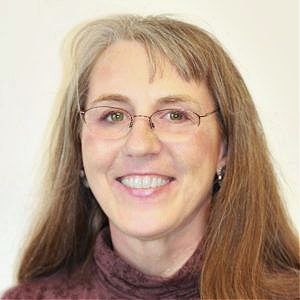 Colleen Ansbaugh
Colleen Ansbaugh
Wabeno, Wisconsin
Colleen learned the basics of quilting from her mother, who was an expert at crazy quilting. She loves the idea of helping the Kenyan embroiderers learn a skill that will earn them money.
Colleen took the idea of ‘art quilt’ quite seriously for this quilt, as her asymmetrical design shows. The quilt is made with raw-edge piecing and additional applique. In an unusual touch, Colleen also added a piece of embroidered tea towel. Colleen used African fabrics which are identified by the wording on the edges. The quilting is done by machine in a free-motion design and the edges are purposely left unfinished.
Colleen is a member of two guilds: A Patch of Lakeshore Quilters in Wisconsin; and Women Who Run with Scissors. She also has served as the Illinois and Wisconsin regional representative of Studio Art Quilt Associates (SAQA).
Oryx
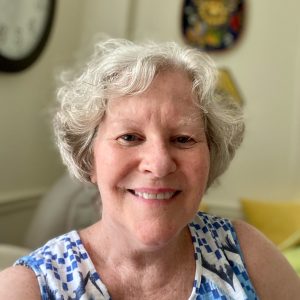 Karen McCann
Karen McCann
Providence, Rhode Island
Karen is a photographer/fiber artist from Rhode Island who supports the mission of Sister Artists. She was pleased to be a “sister from the North” for the first project on Mali.
Hand arts/embroidery is a universal art form women have in common all over the world, and Karen is proud to have worked with Winnie’s embroidered oryx. She stuffed the oryx, to give it definition on the quilt and then layered on some Kantha (an Indian form of embroidery in which old saris are stacked on each other and hand-stitched to make a thin piece of cushion) to represent the Kenyan landscape. Karen used machine stitching to bind the Kantha to her yellow hand-dyed fabric to complete the art quilt.
Karen used rough, raw-edge applique. Most of her quilting is a long hand-stitch embellishment. The fabric colors enhance the colors of the embroidered motif. There is also some machine quilting.
Wading Crane

Sue Willows-Raznikov
San Francisco, California
Sue is a semi-retired university teacher. While her teaching career has kept her engaged academically and socially, Sue always makes time for the arts, gardening, traveling, and birds. When she saw Catherine Nyabuto’s embroidered crane from Kenya, it spoke to her. Indeed, Sue saw the threads and design of this stately bird as an opportunity to escape the Covid-19 pandemic.
Whether Sue is creating an art quilt or a traditional quilt, the process is as important as the finished product. This particular crane needed to have a vertical setting. Half-way through sewing the blocks together, Sue realized that the crane must have been migrating when Catherine saw it in Kenya, and this accounts for the arrows that Sue has added to indicate direction. She has really captured the colors of the embroidered bird in her traditional piecing and uses free-motion quilting throughout to enhance the embroidered motif.
While making her quilt, Sue placed her sewing machine and tables so that she could watch the birds outside her window. This allowed Sue to watch finches and warblers bathing in the birdbath while she was planning and sewing the quilt for Catherine’s lovely embroidered crane. Reflecting on the experience, Sue says, “It is a joy to quilt something so lovely as Catherine’s bird!”
Embroidered Flamingo
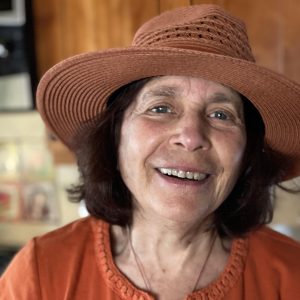 Susan Louis
Susan Louis
Briarwood, New York
Susan Louis has been a quilter for over 30 years. She has taught quilting in every conceivable venue, to every age group (kindergarteners to seniors) and in countries as varied as the US and Russia in 1994 and 1997. Susan’s quilts have been exhibited in major quilt shows in the U.S., France and Russia. She has won a number of ribbons including one for best embellishments at the N.J. Quiltfest.
Susan has always been interested in using her passion for quilting, not just to fulfill her own creative needs, but as a voice for positive change in the world. She has been involved with many quilting projects that she hoped would bring some joy to others and this led her to The Advocacy Project several years ago. After being introduced to AP by Nancy Evans, another skilled quilter, Susan assembled blocks from freed domestic slaves in Nepal into the Sixth Love Blanket.
Embroidered Flamingo is notable for its precise and intricate machine piecing. Susan uses the colors of the embroidered flamingo to unify the quilt. She did the border quilting by hand and the rest of the quilt by machine.
Sister Artists from Kibera
The artists pictured above and profiled below live in the informal settlement of Kibera, a suburb of Nairobi with a population of over 300,000. Kibera is notorious for its lack of services. Many families live on less than a dollar a day and face a daunting array of medical threats, from HIV/AIDS to malaria. The COVID-19 pandemic has added to the challenge.
In spite of this, as their blocks show, the inhabitants of Kibera are resilient, talented and proud of their county’s unique wildlife. Most of the artists learned creative stitching while producing blocks for The Woman’s World Quilt in 2019.
The project was led by Stella Makena, program manager at The Tandaza Trust.
Sister Artists from Kangemi
The artists featured on this page live in the informal settlement of Kangemi, a neighborhood of Nairobi. Kangemi does not have the garish reputation of Kibera, but conditions are almost as bad and were denounced by Pope Francis during a visit in November 2015.
The artists range in age from 18 to 65. As their profiles show, many are single mothers and struggle to put food on the table. About a third produced blocks for the Woman’s World Quilt in 2019. The rest had no prior experience of creative stitching and received training from Christine Kibuka, a well-known fiber artist in Nairobi. They tell us that learning this important new skill together at a time of great anxiety has been proundly therapeutic.
In late 2020, the artists formed the Kagemi Advocacy Self Help Group to facilitate management of the project. The association recently acquired legal status. The artists hope that it can provide a vehicle for a new income-generating project with AP, and a way to advocate for improved services n Kangemi. The project was led by Caren Mbayaki.
Click on this link for more information about the Sister Artists 2 events in March, and social media links!


